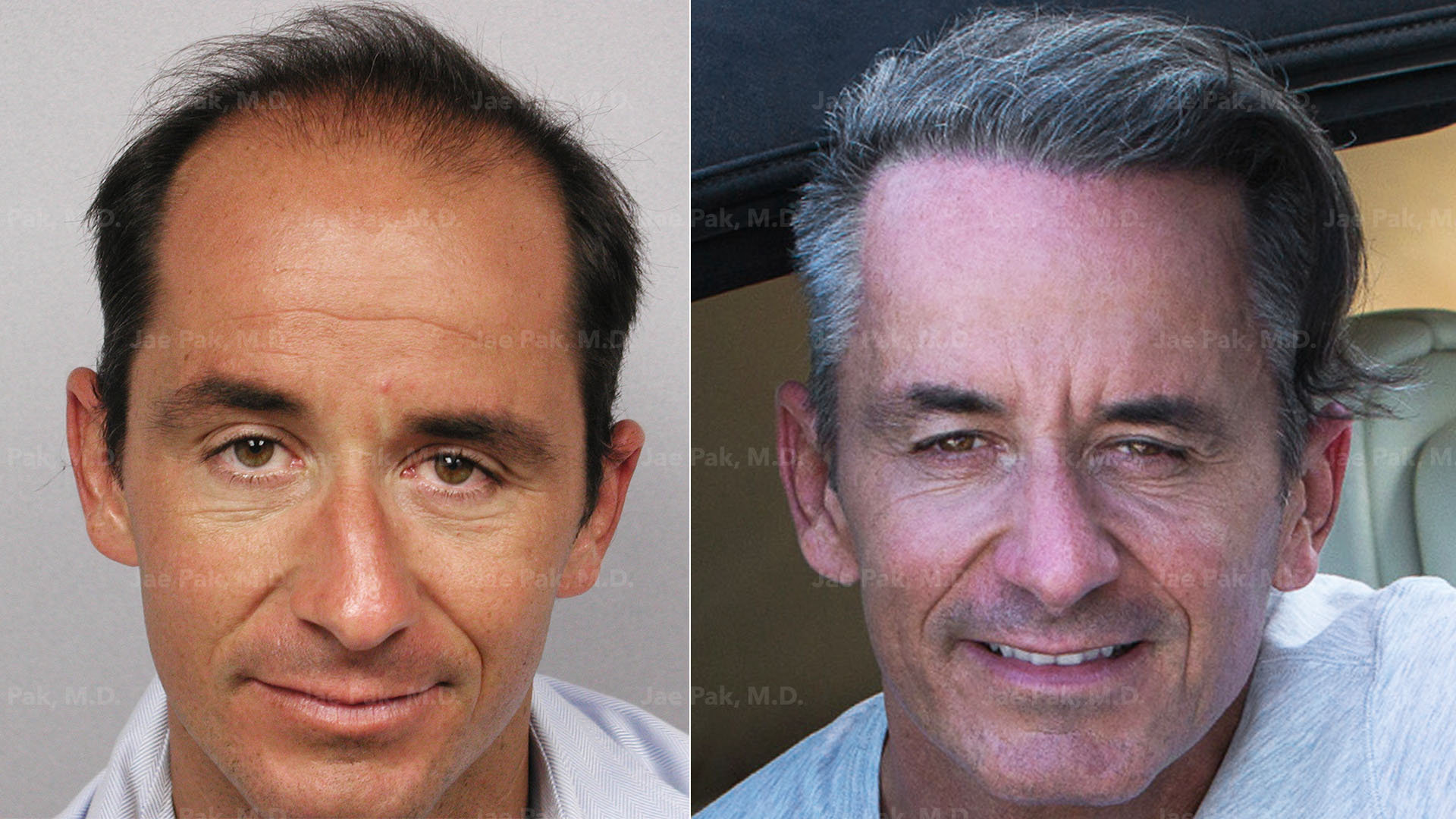
Scientists spend decades putting rockets into space, sending submarines to the depths of the ocean, and unveiling secrets of the universe.
Meanwhile, there are more practical issues at hand – receding hairlines! More than 80 percent of men report major hair loss by the age of 50, while more than 45 percent of women struggle with thinning hair as they age, too.
We turned back the clock just a few decades ago, and we had nowhere near the level of technology or treatment available in 2022. A cure for balding may not exist, but progress has been outstanding on many fronts.
So, exactly what can you expect in terms of modern hair loss treatment, and where should you start on your hair restoration journey? Here are the best ways to treat receding hairlines in 2022, from the tried-and-true basics to the cutting edge of science.
A healthy hairline starts with good lifestyle choices and maybe some natural remedies to aid the body’s ability to grow and maintain strong hair.
Aside from a minimal time investment, there are zero downsides to a diet and exercise program.
More energy, better mood, youthful appearance, and healthy hair are a few main benefits among an endless list.
In terms of specific foods to try, doctors suggest that healthy fats and proteins are optimal for strengthening hair, while processed foods and refined sugars should be kept to a minimum.
A combination of resistance training and cardio is also recommended for a balanced exercise regimen, giving you the best of both worlds for strong muscles and heart health.
With better circulation, higher-quality nutrients, and lower stress from a better lifestyle, these can only help to improve your hairline.
Our hair is made of a similar chemical structure to our skin, nails, teeth, and even some components of our vital organs. We sometimes need an extra boost beyond our daily nutrition to keep these cells healthy, even if we eat well.
For instance, fish oil contains vital omega-3 and omega-6 fatty acids, which have been shown to help hair grow long and strong. Whey protein and amino acids are the building blocks of human cells and have also been linked to hair regeneration in older adults.
You may also find supplements designed for hair restoration, but always examine the ingredients list before spending extra money on a cleverly marketed product.
More often than not, these hair loss supplements contain a predictable mix of multivitamins, minerals, fatty acids, and some extra compounds such as biotin, collagen, and amino acids.
The convenience of these supplements can be helpful for busy individuals, but basic products with these key ingredients will do the job just as well.
Peppermint, rosemary, lavender, even cinnamon – these are essential oils that come from the plants of their namesake and may be helpful in restoring hairlines after a loss has occurred.
Keep in mind that little research exists to back up claims made by those promoting essential oils, but with plenty of anecdotal evidence to support these products, why not give them a try?
Applying essential oils to the scalp must be done carefully, however, with only a small amount of active ingredients necessary to see an effect. Combining just a few drops with a carrier oil like coconut oil will help first-time users enjoy the process and maximize results.
Despite decades of research and billions of dollars in development, only two hair loss drugs have been approved by the Food and Drug Administration.
Both of these medications have a strong track record in clinical trials and patient reviews, so speak with your doctor about trying them out for yourself.
Better known as the generic, over-the-counter Rogaine, Minoxidil is a topical treatment belonging to the vasodilator class of drugs.
Administered twice a day to the crown and hairline, Minoxidil has been shown in some cases to reduce the rate of hair loss in many patients while also promoting the revitalization of lost hair on the scalp.
Yes, Minoxidil may indeed bring your hair back, but results are more common on the crown than the hairline itself.
One of Finasteride’s more powerful DHT-blockers on the market is for men who want to combat hair loss with a small, once-a-day pill. Finasteride is supported by dozens of studies showing strong results, though any newly formed hair will disappear once treatment is discontinued.
A combination of Finasteride and Minoxidil is often prescribed for men in need of a two-tiered approach to hair restoration, as well as patients recovering from a hair transplant.
A step up from medicine is non-invasive treatments to stimulate hair growth and reverse hair loss on the scalp.
Here are some top choices in 2022 for treatments that don’t quite qualify as surgery but still get results for patients every day.
Similar to derma-rolling and microneedling, microchanneling is a professional treatment with many cosmetic applications, including follicle restoration on the hairline.
The mechanism of this treatment is called collagen induction therapy and is typically used to reduce the appearance of wrinkles, acne scars, stretch marks, and other blemishes.
More recently, clinics have discovered increased follicle growth rates in areas that undergo microchanneling, and it’s now a popular treatment for hairline restoration.
Prolonged exposure to short, red-light UV rays has been shown to stimulate blood flow, energize cells, and minimize the aging process in various systems of the body, including the scalp and hairline.
Laser therapy can be done at home, at a salon, and with different purposes.
Like stem cell therapy, PRP uses healthy blood cells from the body to reinvigorate areas of the scalp that need more hair coverage and density.
PRP is still not widely practiced in the field of hair restoration
Sometimes, surgery is the best option for permanent, professional results when restoring your hairline. Here are the three main procedures to consider.
FUT, or strip surgery, is a time-tested procedure involving the extraction of a horizontal portion of hair-bearing skin from the back of the head.
This skin is then dissected into individual follicle units, which are then implanted to the target area of the scalp as needed. FUT is affordable, effective, and ideal for large sessions.
The latest advancement in the hair transplant field is FUE, which lets surgeons pinpoint follicles from the donor area for transplantation to the hairline or crown.
FUE is often more expensive than FUT and may not yield higher volumes of hair. However, the advantages are quicker recovery time and no linear scarring on the back of the heap.

Scalp MicroPigmentation is essentially a high-precision tattoo covering the scalp, designed to appear as a close-cropped head of full hair.
This procedure is perfect for men who enjoy the buzzed look and want a low-maintenance style they can wear consistently for years to come. SMP is also relatively affordable, with a quick recovery time.
The most anticipated advancement in hair restoration is not any single treatment or surgery but the customized strategies created by specialists to maximize results for patients based on their genetics, predicted patterns, and intended outcomes.
In other words, there is no singular method that works for hair loss patients across the board, and more professionals realize the power of personalized care.
While one patient may benefit from a mix of Microchanneling and Finasteride, another might see the best results from FUE transplant, essential oils, and a diet of leafy greens and seafood!
The possible solutions are limitless, and only experienced professionals can make the correct call.
The lesson here is that the future of hair restoration is not about awaiting a particular breakthrough or gene therapy but the ongoing treatment and care for individual patients as they navigate life and track the progress of their hair over time.
That’s why patients should be sure to work closely with a trusted hair restoration specialist who can map out a custom strategy and adjust the action plan as needed over time.
Envision your new hairline today. Speak with Jae Pak, M.D. to see if Hair Restoration is right for you!
Request a Consultation
Whether you’re 25 or 90 years old, genetic hair loss can happen at any time – and progress quickly. The key is to catch it early, map out a strategy, and stick to the game plan with the help of a professional clinic or surgeon.
Now is the best time in history to address hair loss, thanks to a huge range of treatment and quality service that suits your needs as a patient. Use this guide as inspiration, then take control of your hair once and for all.
Sources:
Hereditary-Patterned Baldness | NCBI
Speak with Jae Pak, M.D. today!
Request a Consultation